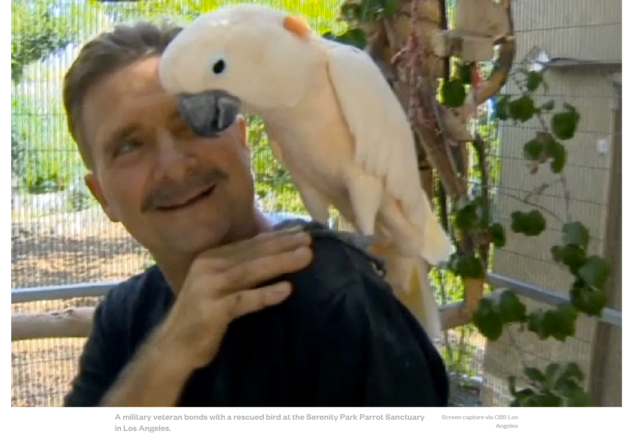The veteran and parrot community exhibit remarkably similar symptoms of post traumatic stress disorder, which is why they are uniquely able to help each heal. This achingly beautiful expose looks at post traumatic stress disorder in parrots and how, in their great intelligence and capacity to detect emotions, these much-abused creatures are drawn to veterans and can help them heal. Explains Matt Simmons, once a highly accomplished military and business man, who got “broken” in combat and found his way back through parrots:
… Now, when I’m with a parrot, it’s not a total time-change thing, but I do have to act like a 12-year-old boy again. And here’s why. Because parrots are not domesticated animals. They haven’t been bred for hundreds of years to be at my feet.’’ Simmons paused for a sip of Coke, the third one of the night. ‘‘So in order to have a relationship with a parrot, that parrot has to select me. In order for that to happen, that parrot has to be comfortable. I have to come in open and quiet and calm. Much like that 12-year-old boy that met the mean dog next door and never had a problem. Much like that 12-year-old boy that went hiking and saw a mountain lion. I’m acting like the 12-year-old boy again around the parrots, and what that does is help me confront my trauma rather than carry it around. Because now I’m with a psychiatrist, and I’m talking about how this bird didn’t feel so good today and wasn’t very comfortable and was kind of hiding in the back of the cage, and the psychiatrist goes, ‘Hmm, you’re starting to talk about emotions.’ I’m talking about how the bird was feeling, but I’m also transferring my own emotions. So being with the parrots allows me to take that third-person look at my own trauma, which you can never do when you’re whacked out on Vicodin and Budweiser and living under a cement highway bridge.
… In one recent psychiatric study conducted at Midwest Avian Adoption and Rescue Services, a parrot sanctuary and rehabilitation facility in Minnesota, a captive-bred male umbrella cockatoo who had been exposed to multiple caregivers who were themselves highly unstable (e.g. domestic violence, substance abuse, addiction) was given a diagnosis of complex PTSD. When examined through the lens of complex PTSD, Dr. Gay Bradshaw, a psychologist and ecologist and an author of the study, wrote, the symptoms of many caged parrots are almost indistinguishable from those of human P.O.W.s and concentration-camp survivors. She added that severely traumatized cockatoos commonly exhibit rapid pacing in cage, distress calls, screams, self-mutilation, aggression in response to .?.?. physical contact, nightmares insomnia.
… Veterans, of course, share similar psychological scarring, but whenever I asked any of them how it is that the parrots succeed in connecting where human therapists and fellow group-therapy members can’t, the answer seemed to lie precisely in the fact that parrots are alien intelligences: parallel, analogously wounded minds that know and feel pain deeply and yet at a level liberatingly beyond the prescriptive confines of human language and prejudices. …
… Abandoned pet parrots are twice-traumatized beings: denied first their natural will to flock and then the company of the humans who owned them. In the wild, parrots ply the air, mostly, in the same way whales do the sea: together and intricately. Longtime pairs fly wing to wing within extended, close-knit social groupings in which individual members, scientists have recently discovered, each have unique identifiable calls, like human names. Parrots learn to speak them soon after birth, during a transitional period of vocalizing equivalent to human baby babbling known as subsong, in order to better communicate with members of their own flocks and with other flocks. This, it turns out, is the root of that vaunted gift for mimicry, which, along with their striking plumages and beguilingly fixed, wide-eyed stares, has long induced us to keep parrots — neuronally hard-wired flock animals with up to 60-to-70-year life spans and the cognitive capacities of 4-to-5-year-old children — all to ourselves in a parlor cage: a broken flight of human fancy; a keening kidnapee. …
…. recent studies of crows and parrots have revealed that birds think and learn using an entirely different part of their brains, a kind of avian neocortex known as the medio-rostral neostriatum/hyperstriatum ventrale. In both parrots and crows, in fact, the ratio of brain to body size is similar to that of the higher primates, an encephalization quotient that yields in both species not only the usual indications of cognitive sophistication like problem-solving and tool use but also two aspects of intelligence long thought to be exclusively human: episodic memory and theory of mind, the ability to attribute mental states, like intention, desire and awareness, to yourself and to others. …
UPDATE (1/14/020): Parrots are innately kind.
Don't I know it. I'm owned by one. Kindness Comes Naturally To #Parrots: Study Shows Their Extraordinary Selfless Behavior. https://t.co/WoTAAixuCL
— ILANA Mercer (@IlanaMercer) January 14, 2020



 print
print